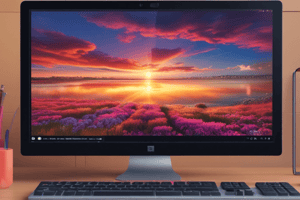Podcast
Questions and Answers
¿Cuál de las siguientes afirmaciones sobre Windows 1 es correcta?
¿Cuál de las siguientes afirmaciones sobre Windows 1 es correcta?
- Requería una unidad de disco duro para su instalación
- Incluía funciones avanzadas como ventanas superpuestas y capacidad de minimizar o maximizar ventanas
- Introdujo la multitarea para aplicaciones heredadas
- Fue el primer sistema operativo de Microsoft con interfaz gráfica de usuario (GUI) (correct)
¿Cuál de las siguientes características NO fue introducida en Windows 2?
¿Cuál de las siguientes características NO fue introducida en Windows 2?
- Multitarea para aplicaciones heredadas (correct)
- Capacidad de minimizar o maximizar ventanas
- Soporte para 256 colores
- Ventanas superpuestas
¿Cuál de las siguientes afirmaciones sobre Windows 3 es FALSA?
¿Cuál de las siguientes afirmaciones sobre Windows 3 es FALSA?
- Introdujo la multitarea para aplicaciones heredadas
- No requería una unidad de disco duro para su instalación (correct)
- Fue el primer sistema operativo de Microsoft con éxito masivo
- Permitió el uso de $256^2$ colores en la interfaz
¿Qué característica importante NO fue mencionada en el artículo para ninguna de las versiones de Windows?
¿Qué característica importante NO fue mencionada en el artículo para ninguna de las versiones de Windows?
¿Cuál de las siguientes afirmaciones sobre la evolución de Windows es VERDADERA?
¿Cuál de las siguientes afirmaciones sobre la evolución de Windows es VERDADERA?
¿Cuál de las siguientes versiones de Windows introdujo las fuentes TrueType y el juego Minesweeper?
¿Cuál de las siguientes versiones de Windows introdujo las fuentes TrueType y el juego Minesweeper?
¿Qué versión de Windows representó un gran avance en usabilidad al introducir el menú de inicio y la barra de tareas?
¿Qué versión de Windows representó un gran avance en usabilidad al introducir el menú de inicio y la barra de tareas?
¿Cuál de las siguientes versiones de Windows fue la primera en admitir la hibernación y jugar un papel crucial en la estrategia de actualización automática de Microsoft?
¿Cuál de las siguientes versiones de Windows fue la primera en admitir la hibernación y jugar un papel crucial en la estrategia de actualización automática de Microsoft?
¿Qué versión de Windows combinó las mejores características de los sistemas operativos empresariales y de consumo de Microsoft?
¿Qué versión de Windows combinó las mejores características de los sistemas operativos empresariales y de consumo de Microsoft?
¿Qué versión de Windows fue la más longeva, disfrutando de soporte durante 13 años?
¿Qué versión de Windows fue la más longeva, disfrutando de soporte durante 13 años?
Flashcards are hidden until you start studying
Study Notes
Evolution of Windows Operating System: Major Updates and Versions
The history of Microsoft Windows spans nearly four decades, starting from its humble beginnings in 1985 with the introduction of the first version. Since then, Windows has undergone numerous updates and iterations, transforming the way people interact with personal computers. This article provides an overview of some of the major updates and versions of the Windows operating system.
Windows 1 (November 1985)
The first version of Windows, released in November 1985, marked the beginning of Microsoft's efforts to create a graphical user interface (GUI) for personal computers. Based on MS-DOS, Windows 1 was notable for its heavy reliance on a mouse, a less common input device at the time. To assist users with this new mode of interaction, Windows 1 came bundled with the puzzle game Reversi.
Windows 2 (December 1987)
Two years after the release of Windows 1, Windows 2 arrived. This version introduced overlapping windows, allowing users to arrange multiple programs on the screen simultaneously. Additionally, it enabled the ability to minimize or maximize windows, the latter of which gives windows a full-screen view.
Windows 3 (May 1990)
Windows 3 was the first version to require a hard drive and was the first to see mainstream success. It brought multitasking to legacy applications and supported 256 colors, providing a more colorful interface. Windows 3 laid the foundation for what would become the dominant graphical environment for the next decade.
Windows 3.1 (April 1992)
An improved version of Windows 3.1 was released in April 1992. This version introduced TrueType fonts, making Windows a viable publishing platform and extending its reach beyond productivity apps. Minesweeper also debuted in this iteration.
Windows 95 (August 1995)
Windows 95, released in August 1995, represented a significant leap forward in terms of usability. It introduced the Start menu and the taskbar, which became staples of the Windows interface. Additionally, the transition from a 16-bit GUI to a 32-bit GUI provided improved performance and expanded memory support.
Windows 98 (June 1998)
Windows 98, released in June 1998, was an upgraded version of Windows 95. It supported multiple monitors and introduced Internet Connection Sharing (ICS), enabling users to share their internet connection with other devices on a local network.
Windows 2000 (February 2000)
Based on the business-oriented Windows NT system, Windows 2000 was released in February 2000. It was the first version to support hibernation and played a crucial role in Microsoft's automatic updating strategy. Windows 2000 Professional also introduced a feature called Window File Protection, preventing installed applications from deleting necessary system files.
Windows XP (October 2001)
Released in October 2001, Windows XP combined the best features of Microsoft's enterprise and consumer lines of operating systems. It brought a visually overhauled Start menu and taskbar, along with ClearType to enhance text readability on LCD screens. Windows XP was the longest-running Microsoft operating system, enjoying support for 13 years.
In conclusion, the evolution of the Windows operating system has been characterized by continuous updates and improvements aimed at enhancing user experience, increasing functionality, and addressing emerging technological needs. From the early days of the first version in 1985 to the current market dominance, Windows has remained a driving force behind personal computing.
Studying That Suits You
Use AI to generate personalized quizzes and flashcards to suit your learning preferences.




